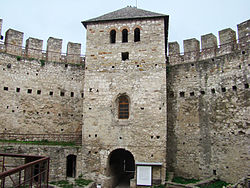Mayor of Soroca
| Soroca | ||
|---|---|---|
| City | ||

|
||
|
||
| Coordinates: 48°10′N 28°18′E / 48.167°N 28.300°ECoordinates: 48°10′N 28°18′E / 48.167°N 28.300°E | ||
| Country |
|
|
| County | Soroca | |
| Government | ||
| • Mayor | Victor Său | |
| Area | ||
| • Total | 11.88 km2 (4.59 sq mi) | |
| Elevation | 45 m (148 ft) | |
| Population (2014) | ||
| • Total | 22,196 | |
| • Density | 1,900/km2 (4,800/sq mi) | |
| Time zone | EET (UTC+2) | |
| • Summer (DST) | EEST (UTC+3) | |
| Postal code | MD-3001 | |
| Area code(s) | +373 230 | |
| Website | Official website | |
Soroca (Russian: Сороки, translit. Soroki, Ukrainian: Сороки, translit. Soroky, Polish: Soroki, Yiddish: סאָראָקע Soroke) is a city and municipality in Moldova, situated on the Dniester river about 160 km north of Chișinău. It is the administrative center of the Soroca District.
The city has its origin in the medieval Genoese trade post of Olchionia, or Alchona. It is known for its well-preserved stronghold, established by the Moldavian prince Stephen the Great (Ştefan cel Mare in Romanian) in 1499. The origins of the name Soroca are not fully known. Its location is only a few kilometers from the Moldova-Ukrainian border.
The original wooden fort, which defended a fjord over Dniester, was an important link in the chain of fortifications which comprised four forts (e.g. Bilhorod-Dnistrovskyi, then known as Akkerman, and Khotyn) on the Dniester, two forts on the Danube and three forts on the north border of medieval Moldova. Between 1543 and 1546 under the rule of Peter IV Rareș, the fort was rebuilt in stone as a perfect circle with five bastions situated at equal distances.
...
Wikipedia


